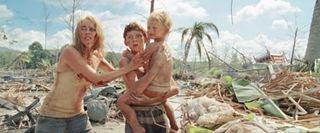TIFF 2012: The Impossible Is Emotional Manipulation Done Almost Perfectly Right

Remember when Clint Eastwood's godawful Hereafter came out in 2010, and everyone said "Well, at least the tsunami sequence is good?" Well, now we can finally forget about that movie entirely thanks to The Impossible, in which Juan Antonio Bayona recreates the 2004 South Pacific tsunami with unforgettable, almost unbearable intensity. The true story that gives the film its narrative is an impressive tale of survival told with maximum schmaltz, and by focusing on a wealthy British family who suffered the tsunami because they were in Thailand on vacation, The Impossible comes dangerously close to minimizing the experience of millions of South Pacific islanders who lost everything in the disaster. But Bayona has picked a story with every emotional note to play, and he plucks those strings perfectly-- whether it's the terror of the tsunami or the emotion of family bonds, this film will get you whether you like it or not.
Though both Bayona and the real family that inspired the story are Spanish, the demands of financing a movie this large have The Impossible following the British Bennett family-- Maria (Naomi Watts) and Henry (Ewan MacGregor), and their three adorable boys (Tom Holland, Oaklee Pendergastst and Samuel Joslin). Bayona, who made the chilling horror thriller The Orphanage, cannily sets up the dread of the tsunami with seemingly innocuous shots of children swimming or the ocean at night, pumping up the sound of the waves crashing to poke at the raw nerves of the audience that's waiting for the worst to strike.
When the water comes, we see Maria and the eldest Lucas (Holland) are carried away in the fast-moving water, struck by debris and grappling for anything to grab hold of, including each other. Bayona pumps up the expert sound design and spins his actors through such chaos it's hard to know quite how they did it. The tsunami sequence is harrowing, but it's not just about pummeling the audience-- Bayona sets up real tension and spatial logic within the rapidly moving water, which is a pretty incredible feat given that every imaginable landmark is moving in the flood. He's not exploiting the disaster for entertainment, but he's not bludgeoning you either-- it's a stunning and unforgettable sequence, and something that the rest of the movie, as you might expect, can't really match.
The tsunami scene is so ruthless and efficient that it's a little surprising when Bayona leans so hard on the emotions later on, with strings coming in to highlight every moment of connection between the surviving strangers, and Fernando Velazquez's score going into overdrive every time a member of the Bennett family has a moment of triumph. Watts and McGregor, along with the very talented young Holland, sell the big feelings well, but their story of survival feels pretty familiar, especially compared to the stunning tsunami sequence that comes before. And though we see other survivors looking for their families or coping with loss, the film's narrow focus on the Bennetts-- and, for that matter, almost exclusively tourists-- starts to lose track of the unbelievable scope of the real-life tragedy.
There was a ton of sniffling and sobbing around me at yesterday's press screening, but also more than a few walkouts, people either too overwhelmed by the film's visceral violence or offended by the manipulative emotions. Both are fair reactions, but neither are reasons not to see The Impossible, which tells the story of an unavoidable natural disaster but still manages to be necessary viewing. Bayona has an incredible power over the audience in The Impossible, and while he might abuse it at moments, he earns it too.
CINEMABLEND NEWSLETTER
Your Daily Blend of Entertainment News
Staff Writer at CinemaBlend
Most Popular







